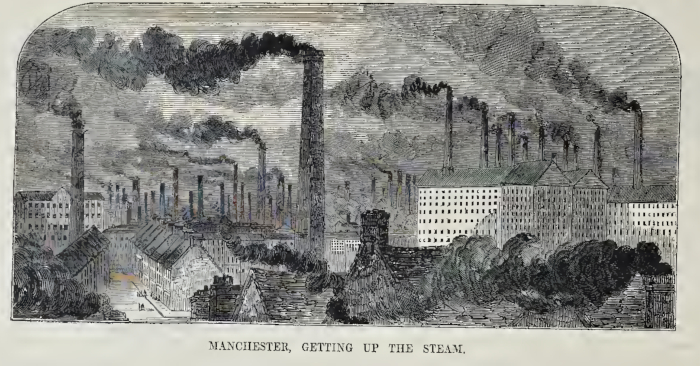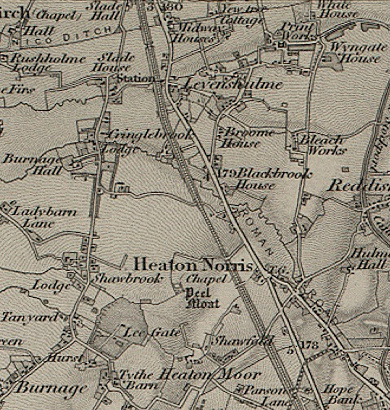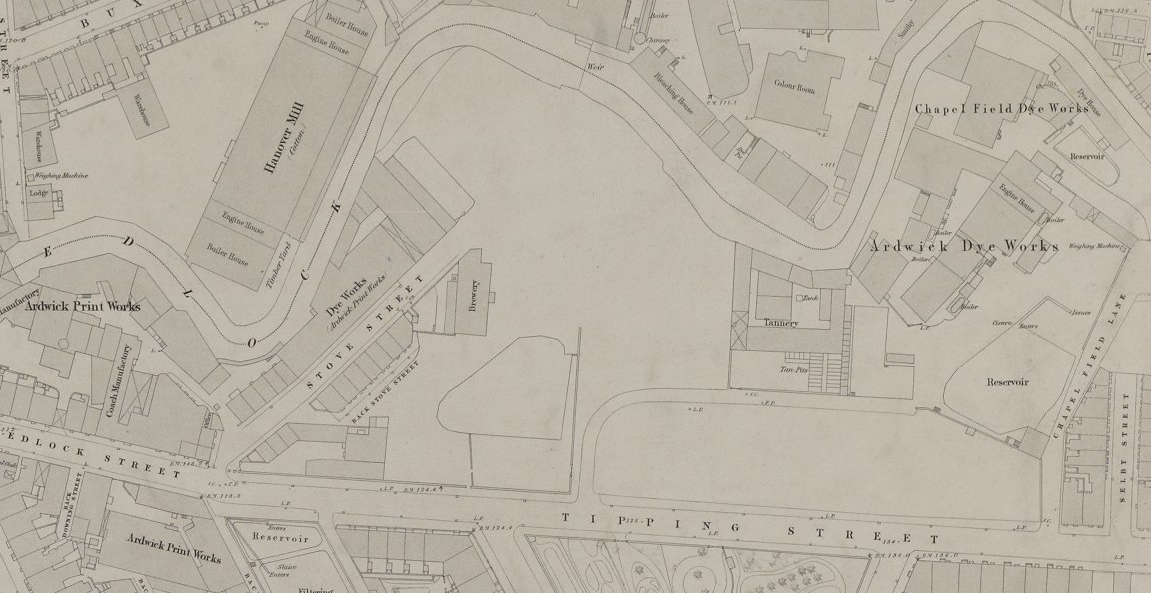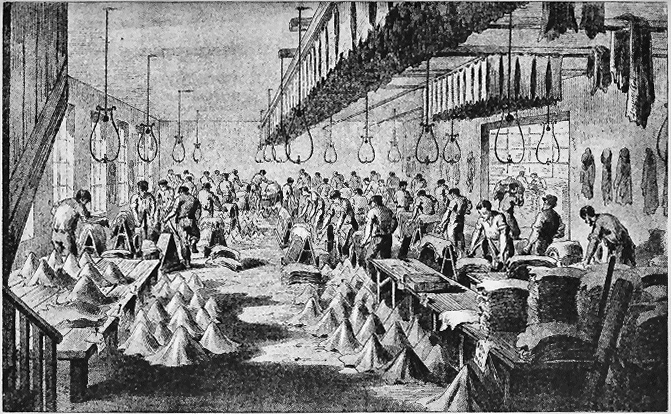The Cunliffes: 19th Century Tanners

This blog will be the first in a short series about the Cunliffe family, related to my wife, their successes and connections as well as their tragedies and drama. In this first post I look at the rise of the family’s tanning business throughout the 19th century. This business formed the backbone of the family bringing them to prominence and providing the wealth that underpinned their other achievements.
I haven’t been able to find any information about the family prior to Thomas Cunliffe (the fourth great-grandfather of my wife), the patriarch of the family, and even he has some pretty major gaps. Whilst in this post I focus on their business in the industrial expansion of Manchester, future posts will look at their social connections, the marriages and dramatic events surrounding the family.
Manchester is world famous as one of the starting points of the industrial revolution, from a small market town on the edge of the Pennines to one of the biggest industrial cities in Britain, this journey took only a few years. Along with this success and growth also came infamy. The ‘horrid little slum’ of ‘Little Ireland’ was recorded in all its horror by Frederick Engels in 1844, and being only a short distance from the Cunliffe tannery it is hard to believe that the family were unaware of this extreme poverty. Yet despite this in 1842 Cooke Taylor wrote in his ‘Tour of the Manufacturing Districts of Lancashire’ that ‘Ardwick knows less about Ancoats than it does about China, and feels more interested in the condition of New Zealand than of Little Ireland’, so who knows?
From Thomas Cunliffe & Co. to Thomas Cunliffe & Sons
Whilst I can’t find evidence of the Cunliffe family before the 1840s, already by that time Thomas Cunliffe had already built up a successful business as a hide merchant. With works in Ardwick backing onto the Medlock (and the Mayfair Depot) on Tipping Street, and a family home in Levenshulme. The business was listed in Manchester directories as ‘Thomas Cunliffe & Co. dealers in hides and sizing, and buffalo skips - 21 Church Street; works Tipping St, Ardwk’ and included a listing for their home in Four Oaks house on Slade Lane in Levenshulme.1

Ordnance Survey First Series, Sheet 88 - 18432
Whilst he is strangely absent from the 1841 census in Levenshulme, his wife, Mary, and children, John, James, William and Harriet are all listed. By this point John and James are in their 20s and are already involved in the family business and are both listed as ‘Hide Dealers’.

Manchester and Salford. Sheet 34, 18513
In 1843 Thomas Cunliffe dissolved the company Thomas Cunliffe & Co, which was created as a partnership between himself and John and Samuel Beckwith.4 This would allow him to continue to grow the company as the sole proprietor before taking on his sons as partner to create ‘Thomas Cunliffe & Sons’.
As the wealth of the family grew, so did their business interests and they split their time largely between Manchester and Warrington where Thomas’s son John Tattersall Cunliffe founded the Union Tannaries Limited in 1867. The family also likely had a second home in Warrington and it would be the location of Thomas’ Cunliffe’s death in 1846. At this point In the 19th century Warrington was a growing hub for tanners and was described as:
“the centre of the northern tanning trade for heavy sole leather: within a radius of a few miles there are over 25 heavy sole tanneries, using on an average from 8,000 to 10,000 hides per week; a great part of the leather used in the boots and shoes manufactured for the army and police is made in this neighbourhood; leather for belts for driving machinery is also made here, and there are manufacturers of picker hides &c.”
*Slater’s Directory of Warrington, Earlestown, Widnes and St. Helens, 1895*
The Mersey had been made navigable in the 18th century making it an attractive location for industry, providing great opportunity for international trade. For the tanners, this meant large quantities of buffalo coming from the US slaughter of bison.
The company produced a wide range of leather goods, and let little go waste. With adverts placed in local papers offering ‘first-class hair’ to be used by plasters, ‘spent bark’ (a byproduct of the tanning process) to be used as mulch by local gardeners and farmers, and tallow, animal fat to be made into candles.5

Capen, Nahum (1852), Biography of Zadock Pratt, of Prattsville, N. Y.
Their business fed into the rapidly accelerating industrialisation of Manchester. The city which was quickly becoming known for its cotton production was at the forefront of the technological innovations which were driving the industrial revolution. In 1847, the oldest of Thomas’ sons, John Tattersall Cunliffe filed a patent for improvements in the ‘pickers of power looms’.6 The ‘pickers’ were an essential component of the power looms that filled many of the Manchester cotton mills, and were conveniently made from strong buffalo hides, a staple of the Cunliffe & Sons business, and it was claimed that their pickers were ‘superior to any hitherto offered’ - a bold claim.7
 Cunliffe’s improvements in pickers, from the London Journal of Arts, Sciences and Manufactures
Cunliffe’s improvements in pickers, from the London Journal of Arts, Sciences and Manufactures
The early years for the family business were not without issue, and in 1860 a fire broke out overnight at the tannery, luckily the fire was quickly extinguished and the £2,000 of damage - reportedly only a fraction of what was on site (and about £250,000 today) was covered by insurance.8

A text-book on tanning, Procter (1885)
The business continued to grow, and provided wealth and influence for many members of the family until its sale in 1892.9
The family
Shortly after buying out the Beckwith’s, in 1846 Thomas Cunliffe died at his Warrington home. Born in the late 18th century he had married Mary Tattersall and had seven children whilst growing his hide trade and tannery business.
His first son, John Tattersall Cunliffe took on the family business, and was born in 1817 whilst the family were living in Chorlton on Medlock.10 In 1820 Elizabeth Ann was born, in 1824 Mary Jane, in 1827 William Edwin (who likely died young), 1829 Selena Ellen, in 1831 William Charles, and Harriet Holt in 1834.
It is likely that there may have been a few more children, including the James who developed the ‘picking’ technologies patented with John in 1847, but I have not been able to find any more information.
John Tattersall Cunliffe 1817 - 1887
The oldest son of Thomas Cunliffe, John quickly became involved in the family business. In 1842 he married Martha Kenworthy, the daughter of wealthy Saddleworth based wool-stapler (a dealer to buys wool from producers and grades it before selling to a manufacturer), Edward Kenworthy.
Their first daughter Helen Cunliffe was born in 1845, followed by Emma in 1847, Edward Kenworthy in 1849 (born deaf), John Tattersall in 1851, Walter in 1852, Jessie in 1855, Frank James in 1856, Martha in 1860, and Ada in 1862.
It is among this next generation of Cunliffe’s that even more interesting stories emerge which will be the subject of the next blog.
Addendum
As of early 2021 the Centre for Applied Archaeology in Salford has been carrying out excavations on the site of the tannery for a planned redevelopment into a large park and commercial space. This excavation has attracted media attention for the spectacularly preserved Mayfield baths from 1850 . I contacted Graham Mottershead from the team, who told me that whilst the they are also devoting the same attention to the other former buildings on the site including the Ardwick Tannery, unfortunately, unlike the nearby dye works it seems that little remains of the original building. Their work will be ongoing and it will take several years for the full report to be released, but hopefully they will uncover some additional information that will add to our knowledge about the Ardwick Tannery and Thomas Cunliffe and Sons.
I have also recently acquired the will of John Tattersall Cunliffe, which adds some new information that I will use to update this blog and others.
References and footnotes
-
This work is based on data provided through www.VisionofBritain.org.uk and uses historical material which is copyright of the Great Britain Historical GIS Project and the University of Portsmouth ↩
-
Map Collection (Flat) C17 (6), Ordnance survey five feet to one statute mile. Manchester and Salford, University of Manchester Library ↩
-
Great Britain (1843). The London Gazette. T. Neuman. ↩
-
‘Plasterers Hair on Sale’ (1866). The Guardian / ‘Spent Bark’ (1854). The Guardian ↩
-
‘The London Journal of Arts, Sciences, and Manufactures, and Repertory of Patent Inventions, Volume 32’ (1848), Newton, W. ↩
-
Manchester Weekly Examiner, (22 May 1847) ↩
-
The Leeds Mercury, ‘Fire in a tannery in Manchester ‘ (21 April 1860) ↩
-
The Guardian, London (1 October, 1892) ↩
-
Manchester, England, Births and Baptisms, 1813 - 1901 (Cathedral), Archival Roll: 757; Page 53; Entry No: 421 ↩
Have something to add?
Comments will be manually added after review.